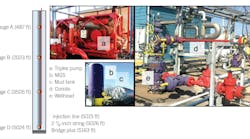Statoil ASA has wrapped up its 2013-14 exploration program in the Barents Sea—one that included a notable disturbance from environmental activists—with fewer commercial discoveries than the company had originally anticipated.
The still-productive campaign accounted for 10% of all exploration wells drilled in the Barents Sea since its opening in 1980—activity Statoil credits with expanding its knowledge through the collection of subsurface data of a variety of geological plays in frontier areas.
The program launched with five wells in the vicinity of Johan Castberg field, which Statoil says were critical in clarifying the oil potential of the area for development planning. The oil discovery in Drivis will be developed as part of the Johan Castberg project (OGJ Online, May 2, 2014).
The three wells drilled in the Hoop area during the summer confirmed a working petroleum system in Hoop, but further work is needed to understand migration and where the oil has accumulated (OGJ Online, Aug. 7, 2014).
Statoil says the Hoop wells were the northernmost ever drilled on the Norwegian continental shelf, residing more than 300 km offshore. The company developed an ice management plan that it intends to utilize in the future, namely following the 23rd concession round. TGS-NOPEC Geophysical Co. in April launched 2D and 3D multiclient projects in the Barents Sea in preparation for the licensing round (OGJ Online, Apr. 24, 2014).
The company considers the noncommercial Pingvin gas discovery northwest of Johan Castberg, made in September, as a play opener, as it proved both hydrocarbons and a reservoir in an unexplored area of the Barents Sea (OGJ Online, Sept. 26, 2014).
“We have also demonstrated that we can operate in a safe and efficient manner in the remote parts of the Barents Sea,” said Irene Rummelhoff, Statoil’s senior vice-president for exploration on the Norwegian continental shelf.
Statoil touted the work of the Transocean Spitsbergen rig, which drilled the last seven wells 40% faster than industry average for the Barents Sea, enabling two more wells than originally planned for to be drilled. The rig, which was illegally boarded by environmental activists from Greenpeace in May, will be suspended in mid-November (OGJ Online, Nov. 6, 2014).
Rummelhoff sees exploring in the Barents Sea as “not a sprint, but marathon.”
“I see our 2013-14 exploration program as an important building block for the future of Barents Sea exploration,” she said. “Our focus next year will be to analyze the extensive data we have collected, interpret the 3D data from the joint seismic acquisition in the southeastern Barents Sea, and decide on the way forward in the Barents Sea. We will also work hard to deliver a strong application in the 23rd concession round.”

